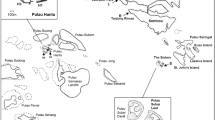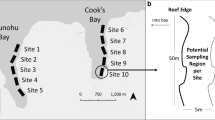Abstract
In the Strait of Georgia and Howe Sound, British Columbia, colonies of individual cloud sponges, growing on rock (known as sponge gardens) receive resource subsidies from the high biodiversity of epifauna on adjacent rock habitats. Bioherms are reefs of glass sponges living on layers of dead sponges. In the same area as the sponge gardens, newly discovered bioherms in Howe Sound, BC (49.34.67 N, 123.16.26 W) at depths of 28- to 35-m are constructed exclusively by Aphrocallistes vastus, the cloud sponge. The sponge gardens had much higher taxon richness than the bioherms. The sponge garden had 106 species from 10 phyla, whereas the bioherm had only 15 species from 5 phyla. For recruiting juvenile rockfish (quillback, Sebastes maliger), the food subsidy of sponge gardens appears to be missing on bioherms of cloud sponge, where biodiversity is relatively low. While adult and subadult rockfishes (S. maliger, S. ruberrimus, S. proriger, and S. elongatus) were present on bioherms, no evidence for nursery recruitment of inshore rockfishes to bioherms was observed, whereas the sponge gardens supported high densities of newly recruited S. maliger, perhaps owing to the combination of both refuge and feeding opportunities. These results indicate that sponge gardens form a habitat for early stages of inshore S. maliger, whereas A. vastus bioherms are associated only with older juvenile and adult rockfishes.





Similar content being viewed by others
References
Buckley RM, Hueckel GJ (1985) Biological processes and ecological developments on an artificial reef in Puget Sound, Washington. Bull Mar Sci 37:50–69
Collie JS, Escanero GA, Valentine PC (2000) Photographic evaluation of the impacts of bottom fishing on benthic epifauna. ICES J Mar Sci 57:987–1001
Conway KW, Barrie JV, Austin WC, Luternauer JL (1991) Holocene sponge bioherms on the western British Columbia continental shelf. Coast Shelf Res 11:771–790
Conway KW, Krautter M, Barrie JV, Neuweiler M (2001) Hexactinellid sponge reefs on the Canadian continental shelf: a unique ‘living fossil’. Geosci Can 28:71–78
Conway KW, Barrie JV, Krautter M (2004) Modern siliceous sponge reefs in a turbid siliciclastic setting: Fraser River delta, British Columbia, Canada. Neues Jahrb Geol Palaeontol 2004:335–350
Conway KW, Barrie JV, Krautter M (2005) Geomorphology of unique reefs on the western Canadian shelf: sponge reefs mapped by multibeam bathymetry. Geo-Mar Lett 25:205–213
Conway KW, Barrie JV, Krautter M (2007) Complex deep shelf habitat: sponge reefs in the Pacific northwest. Geol Assoc Can Spec Pap 47:259–269
Cook SE (2005) Ecology of the hexactinellid sponge reefs on the western Canadian continental shelf. MS dissertation, University of Victoria, Victoria BC
Cook SE, Burd B, Conway KW (2008) Status of the glass sponge reefs in the Georgia Basin. Mar Environ Res 66:S80–S86
Dealteris JT, Kilpatrick BD, Rheault RB (2004) A comparative evaluation of the habitat value of shellfish aquaculture gear, submerged aquatic vegetation and a non-vegetated seabed. J Shellfish Res 23:867–874
Freese JL, Wing BL (2003) Juvenile red rockfish Sebastes sp., associations with sponges in the Gulf of Alaska. Mar Fish Rev 65:38–42
Jamieson GS, Chew L (2002) Hexactinellid sponge reefs: areas of interest as marine protected areas in the North and Central Coast areas. Can Sci Adv Sec Res Doc 2002/122
Krautter M, Conway KW, Barrie JV, Neuweiler M (2001) Discovery of a “living dinosaur”: globally unique modern hexactinellid sponge reefs off British Columbia, Canada. Facies 44:265–282
Krautter M, Conway KW, Barrie JV (2006) Recent hexactinosidan sponge reefs (silicate mounds) off British Columbia, Canada: frame-building processes. J Paleontol 80:38–48
Lamb A, Hanby BP (2005) Marine life of the Pacific Northwest: a photographic encyclopedia. Harbour Publishing, Madeira Park, BC
Love MS, Yoklavich M, Thorsteinson L (2002) The rockfishes of the northeast Pacific. University California Press, Berkeley
Marliave J, Challenger W (2009) Monitoring and evaluating rockfish conservation areas in British Columbia. Can J Fish Aquat Sci 66:995–1006
Martell SJD, Walters CJ, Wallace SS (2000) The use of marine protected areas for conservation of lingcod (Ophiodon elongatus). Bull Mar Sci 66:729–743
Murie DJ (1995) Comparative feeding ecology of two sympatric rockfish congeners, Sebastes caurinus (copper rockfish) and S. maliger (quillback rockfish). Mar Biol 124:341–353
Richards LJ (1986) Depth and habitat distributions of three species of rockfish (Sebastes) in British Columbia: observations from the submersible Pisces IV. Environ Biol Fish 17:13–21
Steimle FW, Figley W (1996) The importance of artificial reef epifauna to black sea bass diets in the Middle Atlantic Bight. North Am J Fish Manage 16:433–439
Taylor RB, Cole RG (1994) Mobile epifauna on subtidal brown seaweeds in northeastern New Zealand. Mar Ecol Prog Ser 115:271–282
Tissot BN, Yoklavich MM, Love MS, York K, Amend M (2006) Benthic invertebrates that form habitat on deep banks off southern California, with special reference to deep sea coral. Fish Bull 104:167–181
Whitney F, Conway K, Thomson R, Barrie V, Krautter M, Mungov G (2005) Oceanographic habitat of sponge reefs on the western Canadian continental shelf. Cont Shelf Res 25:211–226
Worm B, Duffy JE (2003) Biodiversity, productivity and stability in real food webs. Trends Ecol Evol 18:628–632
Acknowledgments
The authors (AL, DMG) gratefully acknowledge years of taxonomic verifications by the experts listed in Lamb and Hanby (2005). John Fisher, Danny Kent, Paul Malcolm, Conor McCracken and other Vancouver Aquarium staff assisted with diving. Kevin Kaufman assisted with graphics. Kris Moulton created the map. Alejandro Frid provided manuscript review comments. Multibeam surveys undertaken by the Canadian Hydrographic Service, Sidney allowed discovery of the deeper water sponge bioherms described in this paper. Steve Taylor (PGC) ably piloted the DFO Remotely Operated Vehicle Monica.
Author information
Authors and Affiliations
Corresponding author
Additional information
Communicated by J. P. Grassle.
Electronic supplementary material
Below is the link to the electronic supplementary material.
Rights and permissions
About this article
Cite this article
Marliave, J.B., Conway, K.W., Gibbs, D.M. et al. Biodiversity and rockfish recruitment in sponge gardens and bioherms of southern British Columbia, Canada. Mar Biol 156, 2247–2254 (2009). https://doi.org/10.1007/s00227-009-1252-8
Received:
Accepted:
Published:
Issue Date:
DOI: https://doi.org/10.1007/s00227-009-1252-8




